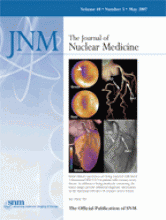Abstract
One of the main degrading factors in the quality of oncologic PET images of the thorax and upper abdomen is respiratory motion of tumors. One method to reduce this effect is the acquisition of PET data in gated mode. A second method is the correction of studies for motion. Motion registration is essential in both cases. We report a method using list-mode data to detect the craniocaudal (z) movement of thoracic and abdominal lesions without using any external gating device. The aim of this study was to show the feasibility of applying this method to patient data. Methods: For 10 patients with lesions in the lung or upper abdominal organs, images for short time bins of 250, 500, and 750 ms were reconstructed. A volume of interest, which was manually defined in a summed image around the structure of interest, was projected to each time bin. The center of mass of the activity distribution in this volume of interest was determined for each case. The curves of the z-coordinate of the center of mass (zCOM) over the time were analyzed and compared with respiration curves obtained by a pressure-sensitive belt. Results: In 7 of the 10 patients, movement of the lesion was registered in good accordance with the pressure belt. In the 3 remaining patients, no changes in the center of mass due to respiration could be detected, most likely because of minimal respiratory motion. The maximal difference in zCOM for a lesion that was detected within the 10-min acquisition was 18.5 mm. For 7 of the 10 patients, the mean value for each respiration amplitude was between 11.0 and 2.0 mm. Conclusion: We have shown the feasibility of registering movement of high-uptake lesions without the use of any external device that may restrain the patient. Furthermore, unlike external sensors, this method quantifies internal motion and, thus, is a promising base for correction methods.
Footnotes
-
COPYRIGHT © 2007 by the Society of Nuclear Medicine, Inc.







